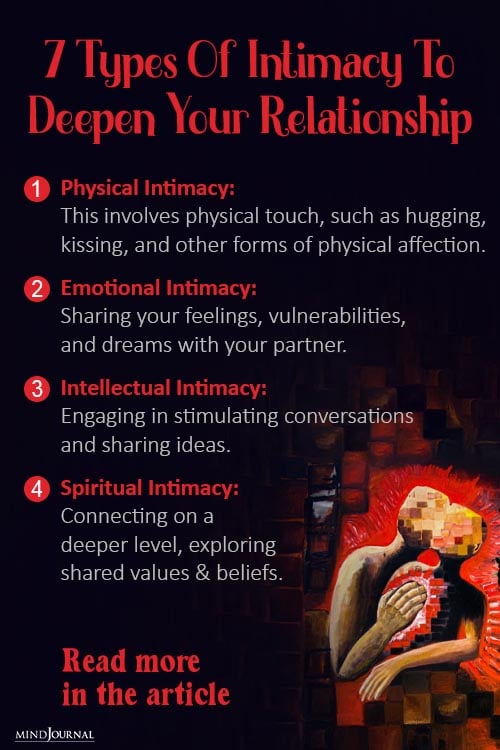Ever wondered how to deepen your bond with your partner? Learning these 7 different types of intimacy in a relationship that can bring you closer in meaningful ways. Try it out now!
Intimacy is important, but how do we cultivate it?
KEY POINTS
- Intimacy is important to the health and longevity of most romantic relationships.
- Sexual intimacy relies on self-disclosure and empathic listening.
- Intimacy includes physical, emotional, intellectual, spiritual, humor, aesthetic, and future-oriented sources.

We’ve all heard that intimacy is central to the health of most long-term romantic relationships. But what is it exactly? And how do we cultivate more of it?
Researchers have found that in the context of sex, intimacy consists of two core elements: self-disclosure and empathy. Partners need to feel comfortable enough with each other to tolerate the vulnerability that comes with being honest about your wants, needs, desires, and fantasies. They must also trust that their partner will respond with openness and empathy rather than ridicule or rejection.
This dynamic of opening up, sharing, listening, and responding empathetically is powerful. It creates a secure environment that invites exploration and a willingness to experiment despite the risk of failure. Intimacy in this context allows partners to relax, be present, and fully enjoy the sexual experience.
Although most people equate the word intimacy with sex, the truth is that many other types of intimacy offer similar opportunities for openness, vulnerability, listening, and connection. Fortunately, all of them interconnect; fostering intimacy in one area of your relationship makes it easier to create intimacy in others.
7 Different Types Of Intimacy In A Relationship
Below are 7 types of intimacy that can be fostered in any long-term romantic relationship:
1. Physical intimacy:
Research shows affectionate touch can powerfully convey positive feelings toward a romantic partner. Yes, sex is important, but physical intimacy isn’t just about what happens between the sheets. It includes all types of nonsexual touch, too, including cuddling, hugging, kissing, and even just snuggling next to each other on the couch.
When couples only engage in physical affection immediately before or during sex, they risk turning the experience into one that feels transactional and devoid of pleasure.
2. Emotional intimacy:
There’s a reason why being a good listener can be a huge turn-on. Sharing your feelings and then listening and responding to those of your partner helps both partners feel safe disclosing important aspects of themselves that don’t get shared with everyone.
The power of this effect was even demonstrated in a famous study, where researchers made strangers in a lab develop romantic feelings for each other simply by having them stare into each other’s eyes and ask successively deeper and personal questions. The study showed that romantic attraction blooms when people take turns revealing their inner emotional world and listening to each other.
3. Intellectual intimacy:
Engaging in long conversations where opinions get shared and ideas and beliefs are exchanged invites intimacy by building respect and admiration. When partners listen and appreciate each other’s opinions over things like current events, books, or causes they feel strongly about, it creates a sense of feeling valued or special, and with that comes trust.
Some people’s romantic feelings for a person are almost solely determined by the quality of these conversations, causing them to identify with a sexual orientation called sapiosexual.
4. Spiritual intimacy:
This type of intimacy might include a connection experienced through shared faith, but it by no means depends on being religious. Spiritual intimacy can refer to feeling safe discussing your shared worldview and values. It also includes your sense of closeness to another over similar life goals—like how you plan to raise children or what’s important to you in a career.
5. Aesthetic intimacy:
If you’ve ever felt more connected to a partner after taking in a beautiful view, savoring an elegant meal, admiring a magnificent painting, or gushing about a mutually enjoyed book, you have experienced aesthetic intimacy. When our partner enjoys and admires what we do, it helps us feel understood and similar.
6. Humor:
When someone laughs at our jokes or finds the same thing funny, it makes us feel like we view the world similarly, including all its absurdities. This doesn’t mean you must laugh at every moment to enjoy an intimate relationship.
And, obviously, when one partner jokes or uses sarcasm at the other’s expense, that can be highly destructive to the relationship. But when partners find the same things ridiculous or comical, humor is a shared language that brings people together.
7. Future-oriented intimacy:
When couples talk and dream about their future together, it signals a sense of commitment and shared vision for what’s to come. These conversations can have a wide range. A newly dating couple might connect over their joint excitement for an upcoming party they plan to attend.
A longer-term couple might bond over fantasizing about the house or children they someday hope to have. Future-oriented intimacy is so potent that it can even be used as a manipulation tactic, such as when one partner pretends to be more excited about their future than they truly are. Social media even has a term for this: “future faking.”

There are numerous ways to build intimacy in a relationship, all of which encourage creating an environment where partners feel safe enough to tolerate the vulnerability of closeness and authenticity. Relationships vary in the extent to which they demonstrate each of the above intimacy types.
That’s perfectly normal and healthy! A good strategy for strengthening your relationship, however, could be to identify the areas of intimacy where you aren’t as strong so that you can foster more closeness within them.
These were some of the different types of intimacy that should be present in a relationship. Which ones do you have? Tell us in the comments!
To follow Dr. McNichols’ work, follow her on Instagram and Tik Tok at @Nicole_TheSexProfessor.
Written by Nicole K. McNichols Ph.D.
Originally appeared on: Psychology Today











Leave a Reply